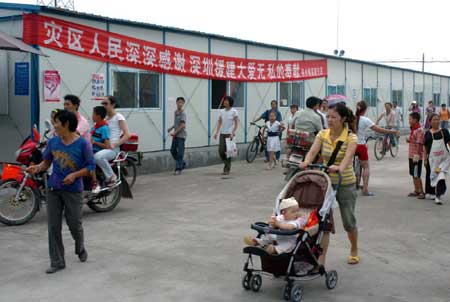For Wang Zhengyou, whose life in the past three months revolved around a tiny construction lot, crouching leisurely in a sofa in his 70-square-meter prefab, with eyes riveted on the TV was a rare pleasure.
 |
|
People walk along prefabs in Shifang City of southwest China's quake-hit Sichuan Province August 12, 2008. The Sichuan Provincial Government announced on Tuesday that the 10 million people or 4.45 million households, whose homes were destroyed by the May 12 earthquake, had all moved into makeshift houses by last Wednesday. [Yuan Jian/Xinhua] |
The 33-year-old man is one of the ten million Sichuan people, whose homes were devastated by a strong 8.0-magnitude earthquake three months ago, to have moved into their makeshift houses, and they will stay there for at least four months.
With cement, bricks, wood, tarp and help from neighbors, Wang built a cozy one-bedroom "apartment" for his three-member family. He got 2,000 yuan (about 285.7 US dollars) government subsidy.
Ten million people, or 4.45 million households, had moved into makeshift houses by last Wednesday, said Hou Xiongfei, spokesman with the Sichuan Provincial Government on Tuesday at a press conference.
About two thirds of the households chose to build their prefabs, each offered 2,000 yuan government subsidy, and the rest moved into houses built by construction workers from other provinces and municipalities.
Hou said that all the government-built prefabs were relatively concentrated, with public bathrooms, clinics, laundries and supermarkets equipped to bring convenience to people there.
The State Council ordered on May 27 that other provinces and municipalities should help the earthquake stricken areas in Sichuan and Gansu provinces to rebuild their homes.
Construction teams from 25 provinces and municipalities rallied in the 3,400 sites of the six worst-hit cities and counties including Wenchuan, Qingchuan and Deyang, and built 500,000 makeshift houses and nearly 100,000 classrooms and clinic wards.
Prefabs in Wenchuan and Qingchuan were built about 30 to 40 km away to their original sites, and the Beichuan county will be rebuilt on a totally different site. "It's more comfortable to live in a house built with my own hands, I will watch the Olympic Games in the house," said Wang.
Wang, who was a migrant worker in south Guangdong Province, rushed back home after the May 12 earthquake, which claimed nearly 70,000 lives, only to find his parents had died in the earthquake and his wife and son were homeless.
He had to go from scratch and build a shelter for his wife and son.
There is still a relatively bumpy road ahead for Sichuan, a province which is now striving to build sufficient permanent structures for the 10 million people before the year end, said Tian Wen, chief engineer of the provincial construction bureau.
"We will try to provide six million people permanent buildings before next January," said Tian, admitting he was not sure whether his bureau will reach the target.
"The problem is we lack building materials and our building speed is not fast enough," said Tian.
The central government enlisted many outdoor travel products and supplies companies to manufacture tents and prefabs just after the earthquake.
President Hu Jintao visited two tent manufacturers in eastern Zhejiang Province in late May, urging them to produce as many as possible to meet the needs of the quake-hit zone.
Wang, who was once worried about the winter shelter for his wife and son, can now start to consider the timetable for leaving home and resuming his work in Guangdong.
(Xinhua News Agency August 13, 2008)